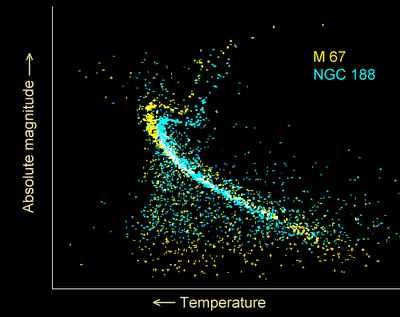
The illustration to the right is a Hertzprung-Russell diagram of two star clusters, and is used to infer ages for these clusters.
How is that done?
Stellar clusters are gravitationally bound and so the stars seem to be of the same general age and composition, also they are at about the same distance from us. So, on the physics of collapsing Hydrogen-rich gas clouds (in turn based on relativity, atomic physics, spectroscopy etc), star formation, and the resulting life cycle, in particular the model timeline for main sequence turnoffs to the giant band, we can estimate the age of the cluster.
In this case, M67 is estimated at ~ 4BY, and NGC 188 at ~ 5 BY. (SOURCE: Wiki CCA, by Worldtraveller.)
What is the relevance of all this to Toronto’s blunder?
Simple, this is a case from an uncontroversial field, which shows the Newtonian uniformity principle in action and how it is used in an inference to best explanation regarding things we cannot directly observe or measure in science. Namely, we observe features of a given phenomenon and identify characteristic traces that — based on things we can directly observe and their logical or causal consequences — will serve as distinct signs that we may confirm as markers of what we did not actually directly see. (In short, even though we know it is possible that something else may intervene, in absence of positive reason to so conclude, the best explanation of deer tracks is a deer, cf. here at UD recently.)
It is worth clipping from Newton’s rules of scientific reasoning:
Rule I [[–> adequacy and simplicity]
We are to admit no more causes of natural things than such as are both true and sufficient to explain their appearances . . . .
Rule II [[–> uniformity of causes: “like forces cause like effects”]
Therefore to the same natural effects we must, as far as possible, assign the same causes.
As to respiration in a man and in a beast; the descent of stones in Europe and in America; the light of our culinary fire and of the sun; the reflection of light in the earth, and in the planets.

nising not only design theory (he accuses us of circular reasoning) but failing to understand how abduction works in science to explain on best and provisional inference what we did not or cannot directly observe in light of key signs and causes we do observe that leave the same sort of traces
With this principle in mind, we are now ready to see where Toronto went so far wrong as to make himself a poster child for the errors we are dealing with. Citing his already linked comment at TSZ of Aug 19th, where the clip begins with a comment I made at UD:
Kairosfocus [Cf. original Post, here]: “You are refusing to address the foundational issue of how we can reasonably infer about the past we cannot observe, by working back from what causes the sort of signs that we can observe. “
[Toronto:] Here’s KF with his own version of “A concludes B” THEREFORE “B concludes A”.
Oops.
Let’s take it from the top, bearing in mind the parallel case we already looked at:
1 –> In science (and in other fields of significance) we are often interested in getting an accurate understanding of what may have happened in the unobserved or unobservable past, or in places and objects that we cannot directly inspect.
2 –> In such cases, we are led by the logic of inference to best explanation. The Information Philosopher cites Gilbert Harman:
The inference to the best explanation” corresponds approximately to what others have called “abduction,” the method of hypothesis,” “hypothetic inference,” “the method of elimination,” “eliminative induction,” and “theoretical inference.”
I prefer my own terminology because I believe that it avoids most of the misleading suggestions of the alternative terminologies.
In making this inference one infers, from the fact that a certain hypothesis would explain the evidence, to the truth of that hypothesis. In general, there will be several hypotheses which might explain the evidence, so one must be able to reject all such alternative hypotheses before one is warranted in making the inference. Thus one infers, from the premise that a given hypothesis would provide a “better” explanation for the evidence than would any other hypothesis, to the conclusion that the given hypothesis is true.
3 –> In short, we consider the alternatives that are possible and try to eliminate down to the remaining one. Of course, in science we cannot eliminate all possible hypotheses, so we infer provisionally on a best current explanation basis.
4 –> Where, we accept that if a pattern of plausible initial and intervening conditions and known laws and statistical patterns could reasonably produce an effect this is reasonably the best explanation. Such as the way we explain the HR diagram of the stellar clusters with their branches from the main sequence heading to the giants bands above.
5 –> Likewise, when we see the characteristic sign of a deer track, we normally infer to deer as best explanation. Let me add:

6 –> Now, there is indeed a point where fallacious circularity could enter the picture.
7 –> Ironically, it is a problem that design theorists and others have repeatedly pointed out to a priori materialists of the Lewontinian stripe: if there is a known possible causal factor that could explain an effect more readily than one’s preferred materialist scheme, then it is improper to play gerrymandering games with the rules and methods of science to lock it out of consideration.
8 –> In the case of design theory, we do have a vast empirical base that shows that routinely functionally specific and complex organisation and information are produced by designers, using processes of intelligently and purposefully directed configuration and contingency.
9 –> Not only so, but such is the ONLY observed cause of such FSCO/I. In short there is good reason to infer that this is an empirically reliable sign of design. Thence, to infer from it that things which show this feature may be best explained as designed.
10 –> What does Toronto do to lock this out? He tries to twist about the question-begging, by ignoring the nature of empirically anchored, provisional inference to best current explanation, and caricaturing the argument then falsely accusing those who properly use such an abductive process of fallacious question-begging.
_____________
That’s rich.
And so, Toronto joins our list of poster children for the errors of a priori evolutionary materialism and its fellow travellers. END